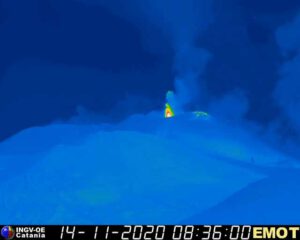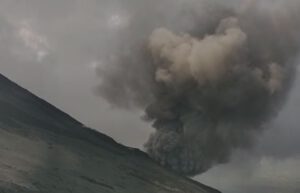 At the Guatemalan volcano Pacaya, volcanic activity increased significantly yesterday afternoon. Social media reports published images showing an ash cloud rising from the flank of the McKenney crater cone. Some comments say that a new crater has formed. However, other phenomena may also cause ash to rise from the flank: One would be the formation of a fracture (fissure) from which a new lava flow flows. On the other hand, blocks could break off from the front of a lava flow and trigger ash flows. CONRED warns of an increase in activity and reports that blocks up to 3 m in size break off from the center of the cone. The block avalanches are moving on the southwest flank of the volcano.
At the Guatemalan volcano Pacaya, volcanic activity increased significantly yesterday afternoon. Social media reports published images showing an ash cloud rising from the flank of the McKenney crater cone. Some comments say that a new crater has formed. However, other phenomena may also cause ash to rise from the flank: One would be the formation of a fracture (fissure) from which a new lava flow flows. On the other hand, blocks could break off from the front of a lava flow and trigger ash flows. CONRED warns of an increase in activity and reports that blocks up to 3 m in size break off from the center of the cone. The block avalanches are moving on the southwest flank of the volcano.
Year: 2020
Etna: Thermal anomalys detected
At Etna in Sicily strombolian eruptions can be observed today. They originate from the New South East Crater and create a distinct thermal anomaly: MIROVA registers a high thermal radiation with a power of 116 MW. It comes from the tephra deposited in the crater. In the conveyor system, the magma stands high. On a 3 day old satellite image 2 small hotspots in Bocca Nuova were also visible. Another anomaly was found in the Northeast Crater.
More informations about Mount Etna on the mainpage.
Stromboli: larger eruption on 10.11.20
 Yesterday evening at 20:04 a major explosive eruption occurred on Stromboli. Glowing tephra covered the crater and its southern flank. However, it is not yet clear whether larger cinders also landed on the Cima and Pizzo. According to first reports the measuring instruments remained undamaged. The explosion was preceded by a 4 minute inflation phase. It raised the inclinometer on the Rina Grande by 1 µrad. The threshold value for the duration of the soil uplift was not reached and so the automatic paroxysm early warning system did not trigger an alarm. Nor was the eruption a paroxysm, but a single explosion. Such explosions occur again and again on Stromboli, even during relatively calm phases, as we are currently experiencing on Stromboli. All parameters of the daily events at the volcano were inconspicuous in the run-up to the explosion. The activity index has been set to “low” for quite some time.
Yesterday evening at 20:04 a major explosive eruption occurred on Stromboli. Glowing tephra covered the crater and its southern flank. However, it is not yet clear whether larger cinders also landed on the Cima and Pizzo. According to first reports the measuring instruments remained undamaged. The explosion was preceded by a 4 minute inflation phase. It raised the inclinometer on the Rina Grande by 1 µrad. The threshold value for the duration of the soil uplift was not reached and so the automatic paroxysm early warning system did not trigger an alarm. Nor was the eruption a paroxysm, but a single explosion. Such explosions occur again and again on Stromboli, even during relatively calm phases, as we are currently experiencing on Stromboli. All parameters of the daily events at the volcano were inconspicuous in the run-up to the explosion. The activity index has been set to “low” for quite some time.
Karymsky: Eruption update 09.11.20
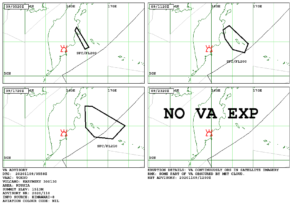 Since yesterday, the Karymsky erupts again ash clouds on Kamchatka (Russia). The VAAC issued 4 VONA warnings for air traffic. Volcanic ash was detected at 6000 m altitude. The ash drifted in northeast direction. Further eruptions of the remote volcano are expected.
Since yesterday, the Karymsky erupts again ash clouds on Kamchatka (Russia). The VAAC issued 4 VONA warnings for air traffic. Volcanic ash was detected at 6000 m altitude. The ash drifted in northeast direction. Further eruptions of the remote volcano are expected.
In the literature Karymsky is often mentioned as the most active volcano of Kamchatka. Until 2016, the volcano was permanently active and erupted several times a day. But this has changed significantly in the meantime. In the meantime, the Karymsky is active in phases and breaks of several months can occur. The Klyuchevskoy, which erupts more frequently and more strongly in the meantime, competes with the Karymsky.
Klyuchevskoy: Activity increases
 The volcano on Kamchatka put on an impressive performance yesterday. The output of lava increased. MIROVA registered the highest value of thermal radiation to date: 1454 MW. So the lava flow might have become longer than 1 km. At the moment a power of 1000 MW is still registered. On the LiveCam one could observe large strombolian eruptions. This morning an ash cloud was erupted. According to the VAAC it rose up to a height of 6000 m.
The volcano on Kamchatka put on an impressive performance yesterday. The output of lava increased. MIROVA registered the highest value of thermal radiation to date: 1454 MW. So the lava flow might have become longer than 1 km. At the moment a power of 1000 MW is still registered. On the LiveCam one could observe large strombolian eruptions. This morning an ash cloud was erupted. According to the VAAC it rose up to a height of 6000 m.
Etna: Swarm earthquake stronger
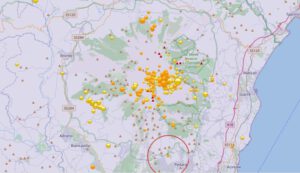 Already yesterday I reported about an earthquake swarm, which today presents itself much stronger than it first appeared. SismoWeb (INGV) today shows 53 earthquakes for November 5. Most of the tremors occurred about 2 km south of Pizzo Deneri on the northern side of Etna. The strongest single quake occurred on M 3.1 with a hypocenter at 3.2 km depth. The majority of the other quakes had magnitudes between 1 and 2. The hypocenters were mostly at depths less than 5 km. This was the strongest earthquake swarm of the last months at Etna. It is very well possible that the quakes were caused by rising magma. An eruption in the upper part of the Valle del Bove, respectively at the base of the Northeast Crater is possible in the medium term. However, it is known that the entire eastern flank of the volcano is moving and the quakes could also be related to tectonic processes.
Already yesterday I reported about an earthquake swarm, which today presents itself much stronger than it first appeared. SismoWeb (INGV) today shows 53 earthquakes for November 5. Most of the tremors occurred about 2 km south of Pizzo Deneri on the northern side of Etna. The strongest single quake occurred on M 3.1 with a hypocenter at 3.2 km depth. The majority of the other quakes had magnitudes between 1 and 2. The hypocenters were mostly at depths less than 5 km. This was the strongest earthquake swarm of the last months at Etna. It is very well possible that the quakes were caused by rising magma. An eruption in the upper part of the Valle del Bove, respectively at the base of the Northeast Crater is possible in the medium term. However, it is known that the entire eastern flank of the volcano is moving and the quakes could also be related to tectonic processes.
Vulkaneifel: Soil uplift at Laacher See proven
 It has often been speculated whether a series of earthquakes at the Laacher Lake volcano, which occurred between 2013 and 2018, might not have been related to the intrusion of magmatic fluids. Now this assumption seems to be confirmed. The confirmation can be found in the form of a new map of the German authority BGR (Bundesanstalt für Geowissenschaften und Rohstoffe), which has been prepared within the framework of the Boden-Bewegungsdienst-Deutschland.
It has often been speculated whether a series of earthquakes at the Laacher Lake volcano, which occurred between 2013 and 2018, might not have been related to the intrusion of magmatic fluids. Now this assumption seems to be confirmed. The confirmation can be found in the form of a new map of the German authority BGR (Bundesanstalt für Geowissenschaften und Rohstoffe), which has been prepared within the framework of the Boden-Bewegungsdienst-Deutschland.
With the help of this map, primarily ground movements which have been caused by mining are to be represented. These are usually ground subsidence which can cause damage to the infrastructure. In fact, the satellites used to create the map did not only detect ground subsidence, but also ground uplift. It is located under the village of Glees, 2 km northwest of Lake Laach. The satellite data show that the ground rose by about 40 mm between 2014 and 2019.
In my opinion, the newly discovered ground uplift would justify a continuous observation of the Laacher See volcano and its surroundings, at least until it can be excluded that the ground deformation is of magmatic origin. Although it is still a small-scale uplift, without regular observation it is not known whether it is increasing. Theoretically an eruption could occur within a few months/years. If the fluid is magma.
Sinabung increases its activity
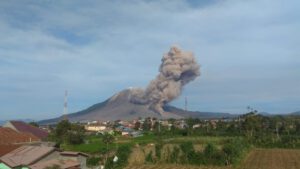 The volcano Sinabung is located on the Indonesian island of Sumatra and increased its activity. Already on October 20, the seismic activity increased rapidly, and in addition to volcanically induced earthquakes, numerous seismic signals were picked up, which were triggered by the discharge of debris avalanches. Yesterday at least one pyroclastic flow was generated, which was photographed but has not yet been included in the MAGMA/VSI updates. The stream had a length of about 1500 m and was active for almost 4 minutes. The events suggest that the lava dome has received a new growth spurt and reached a critical size. It is expected that further pyroclastic flows will be generated in the near future. There is also the danger that a larger part of the dome will collapse. Visual observations of the dome are rare these days because the top of the volcano is mostly hanging in the clouds.
The volcano Sinabung is located on the Indonesian island of Sumatra and increased its activity. Already on October 20, the seismic activity increased rapidly, and in addition to volcanically induced earthquakes, numerous seismic signals were picked up, which were triggered by the discharge of debris avalanches. Yesterday at least one pyroclastic flow was generated, which was photographed but has not yet been included in the MAGMA/VSI updates. The stream had a length of about 1500 m and was active for almost 4 minutes. The events suggest that the lava dome has received a new growth spurt and reached a critical size. It is expected that further pyroclastic flows will be generated in the near future. There is also the danger that a larger part of the dome will collapse. Visual observations of the dome are rare these days because the top of the volcano is mostly hanging in the clouds.
Iceland: Earthquake M 5.6
 On the Icelandic Reykjanes Peninsula, the earthquake struck this afternoon at 13.43 UCT with a magnitude of 5.6, with the epicenter located 3.9 km west of Krýsuvík and only a few kilometers from Grindavik. The hypocenter was located at a depth of 3.3 km. The quake could be felt in large parts of southwest Iceland and shook the capital. For Iceland it was a strong quake. There were numerous aftershocks, although I would honestly say that the main quake triggered a seismic swarm. So far 219 quakes have been registered, 12 with magnitudes greater than 3.
On the Icelandic Reykjanes Peninsula, the earthquake struck this afternoon at 13.43 UCT with a magnitude of 5.6, with the epicenter located 3.9 km west of Krýsuvík and only a few kilometers from Grindavik. The hypocenter was located at a depth of 3.3 km. The quake could be felt in large parts of southwest Iceland and shook the capital. For Iceland it was a strong quake. There were numerous aftershocks, although I would honestly say that the main quake triggered a seismic swarm. So far 219 quakes have been registered, 12 with magnitudes greater than 3.
Alaska: Earthquake Mw 7,5
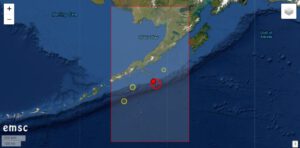 Off the coast of the US state of Alaska, the earth shook last night with a magnitude of 7.5, the epicenter being located 84 km southeast of Sand Point. This is a place on the Aleutian island of Unalaska. The hypocenter was at a depth of 40 km. Despite the relatively large depth of the earthquake epicenter there was a tsunami alarm. The same applies to larger damages. The region is only sparsely populated. In relative proximity to the location of the earthquake are some volcanoes that are classified as potentially active: Mount Makushin, Mount Okmok and the volcanic island of Bogoslof, to name only 3. The volcanism of the region is directly related to the Aleutian subduction zone where the earthquake occurred.
Off the coast of the US state of Alaska, the earth shook last night with a magnitude of 7.5, the epicenter being located 84 km southeast of Sand Point. This is a place on the Aleutian island of Unalaska. The hypocenter was at a depth of 40 km. Despite the relatively large depth of the earthquake epicenter there was a tsunami alarm. The same applies to larger damages. The region is only sparsely populated. In relative proximity to the location of the earthquake are some volcanoes that are classified as potentially active: Mount Makushin, Mount Okmok and the volcanic island of Bogoslof, to name only 3. The volcanism of the region is directly related to the Aleutian subduction zone where the earthquake occurred.
As is typical for earthquakes of this magnitude, there were numerous aftershocks. The strongest one had the magnitude 5.9 and further aftershocks must be expected.
